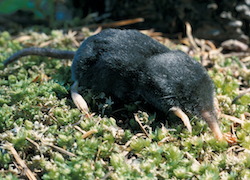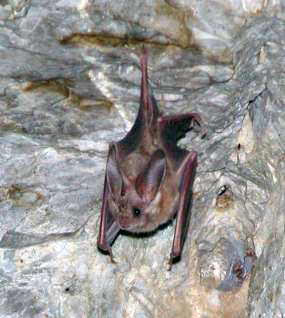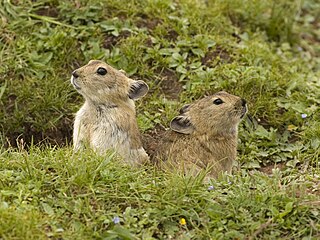 W
WThe American shrew mole is the smallest species of mole. It is the only living member of the genus Neurotrichus and the tribe Neurotrichini. It is also known as Gibb's shrew mole and least shrew mole. It is not closely related to the Asian shrew mole. The reason that it is called a "shrew mole" instead of being called either a "shrew" or a "mole" is because of its fur, which is a characteristic of shrews and its large head and heavy dentition, which is characteristic of moles.
 W
WThe Amur hedgehog, also called the Manchurian hedgehog, is a hedgehog similar to the European hedgehog in appearance and behaviour, although it is more lightly coloured. It is native to Amur Oblast and Primorye in Russia, Manchuria in China, and the Korean Peninsula. Like other hedgehogs, it uses scent and hearing while looking for prey, and the name "hedgehog" refers to the pig-like grunts it makes as it forages.
 W
WThe California leaf-nosed bat is a species of bat in the family Phyllostomidae. It is found in Mexico and the United States. Its natural habitat is hot deserts. It is threatened by habitat loss.
 W
WThe desert cottontail, also known as Audubon's cottontail, is a New World cottontail rabbit, and a member of the family Leporidae. Unlike the European rabbit, they do not form social burrow systems, but compared with some other leporids, they are extremely tolerant of other individuals in their vicinity.
 W
WThe dire wolf is an extinct species of the genus Canis. It is one of the most famous prehistoric carnivores in North America, along with its extinct competitor, the sabre-toothed cat Smilodon fatalis. The dire wolf lived in the Americas and China during the Late Pleistocene and Early Holocene epochs. The species was named in 1858, four years after the first specimen had been found. Two subspecies are recognized: Canis dirus guildayi and Canis dirus dirus. The dire wolf probably evolved from Armbruster's wolf in North America. The largest collection of its fossils has been obtained from the Rancho La Brea Tar Pits in Los Angeles.
 W
WThe dubious trumpet-eared bat is a species of vesper bat in the family Vespertilionidae. It is found only in possibly South Africa.
 W
WThe dusky-footed woodrat is a species of nocturnal rodent in the family Cricetidae. They are commonly called "packrats" or "trade rats" and build large, domed dens that can reach several feet in height. Coyotes and other predators will attempt to prey on these rodents by laying waste to the dens, but the sheer volume of material is usually dissuasive. Occasionally, dusky-footed woodrats will build satellite dens in trees. Although these animals are religiously solitary, except in the mating season, dens are frequently found in clusters of up to several dozen, forming rough "communities". The mating system in this species appears to be variable, with promiscuity most generally at high population densities and monogamy at lower densities.
 W
WGould's long-eared bat is a microbat found in southern regions of Australia. It occurs in eastern Australia, from Queensland to Victoria, and in a smaller isolated range in the south-west of Western Australia.
 W
WThe hispid pocket mouse is a large pocket mouse native to the Great Plains region of North America. It is a member of the genus Chaetodipus.
 W
WHoffmann's two-toed sloth is a species of sloth from Central and South America.
 W
WThe little bent-wing bat or little long-fingered bat is a species of vesper bat in the family Miniopteridae. It is found in Australia, Indonesia, the Philippines, and Vanuatu.
 W
WThe Manitoba wolf, also known as the grey-white wolf, is an extinct subspecies of gray wolf that roamed in the southern Northwest Territories, northern Alberta, Saskatchewan, and south-central Manitoba. This wolf is recognized as a subspecies of Canis lupus in the taxonomic authority Mammal Species of the World (2005).
 W
WThe cactus mouse is a species of rodent in the family Cricetidae. It is one species of a closely related group of common mice often called deer mice. Cactus mice are small, between 18 and 40 g in weight. Females weigh slightly more than males and are significantly larger in body length, ear length, length of mandible, and bullar width of skull. Cactus mice can be identified by having naked soles on their hind feet and almost naked tails, which are usually the same length or longer than the animals' body length. Their ears are nearly hairless, large, and membranous. Their fur is long and soft; coloration varies between subspecies and between different populations. Color of fur varies from ochre to cinnamon, with white ventral areas, and the sides and top of head slightly grayish. Females tend to be slightly paler in color than males, while juveniles appear more gray than their parents.
 W
WThe plateau pika, also known as the black-lipped pika, is a species of mammal in the pika family, Ochotonidae.
 W
WRichardson's ground squirrel, also known as the dakrat or flickertail, is a North American ground squirrel in the genus Urocitellus. Like a number of other ground squirrels, they are sometimes called prairie dogs or gophers, though the latter name belongs more strictly to the pocket gophers of family Geomyidae, and the former to members of the genus Cynomys.
 W
WThe round-tailed ground squirrel, known as "Ardillón cola redonda" in Spanish, live in the desert of the Southwestern United States and Northwestern Mexico. They are called "ground squirrels" because they burrow in loose soil, often under mesquite trees and creosote bushes.
 W
WThe sand cat, also known as the sand dune cat, is a small wild cat living in sandy and stony deserts far from water sources. With its sandy to light grey fur, it is well camouflaged in a desert environment. Its head-and-body length ranges from 39–52 cm (15–20 in) with a 23–31 cm (9.1–12.2 in) long tail. Its 5–7 cm (2.0–2.8 in) long ears are set low on the sides of the head, aiding detection of prey moving underground. The long hair covering the soles of its feet insulate its foot pads against the extremely hot and cold temperatures in deserts.
 W
WThe striped possum or common striped possum is a member of the marsupial family Petauridae. The species is black with three white stripes running head to tail, and its head has white stripes that form a 'Y' shape. It is closely related to the sugar glider, and is similar in appearance.
 W
WThe Sulawesi dwarf cuscus is a species of arboreal marsupial in the family Phalangeridae endemic to Sulawesi and nearby islands in Indonesia. It inhabits tropical moist lowland forest and is nocturnal, folivorous and usually found in pairs. S. celebensis is threatened by hunting and deforestation.
 W
WWallace's dasyure or Wallace's three-striped dasyure is a member of the order Dasyuromorphia. This marsupial carnivore is found in Indonesia and Papua New Guinea. Specifically, it's found on the Aru Islands of the Maluku Province of Indonesia.